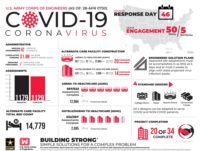MetroSouth Hospital Was Revived as a COVID-19 Alternate Care Facility

The MetroSouth Hospital alternate care facility required new equipment, including medical gas tanks.
PHOTOS COURTESY OF CLARK CONSTRUCTION

Clark Construction used a crane to install the medical-gas tanks.


On a Friday evening in March, early in the COVID-19 pandemic, David Trolian saw a unique request for proposals from the U.S. Army Corps of Engineers. Responses to the RFP were due the next afternoon. Once awarded, teams would need to be on site and working within 24 hours.
Trolian, division president and CEO of Clark Construction Group in Chicago, applied in partnership with Chicago design firm Perkins & Will. They’d use a design-build methodology, led by the contractor. The proposal emphasized the team’s readiness and skill.
By that Sunday, the Clark/Perkins & Will design-build team was awarded the $14.9-million job. On Monday, they were on site trying to transform a 500,000-sq-ft existing building, a closed hospital, into an alternate care facility.
“It was a pretty busy weekend,” Trolian said.
The project was to turn the shuttered MetroSouth Medical Center in Blue Island, Ill., into an alternate care facility where COVID-19 patients could receive medical care if area hospitals were overwhelmed. The facility would need to be ready to treat patients in 26 days.
“I’d say in my 26-year career, this felt like the most important project.”
– David Trolian, CEO, Clark Construction
In the wake of the pandemic, a number of alternate care facilities were built for the Federal Emergency Management Agency by the USACE across the country. In Illinois, McCormick Place received the most news coverage, but three other facilities were constructed—MetroSouth, as well as the former Sherman Center Street Campus in Elgin, Ill., and Westlake Hospital in Melrose Park, Ill. These projects are similar to disaster relief work, Trolian said. The work—like the response period—needs to be swift, exact and transparent.
On the first day of the MetroSouth project, Emily Bateman, a project manager and an associate at Perkins & Will, saw about 100 people on site. Everyone needed to see the building at least once in person to know what they were working with, she said, but it was still the early, confusing days of the pandemic. Quickly, the Clark team set up protocols and screening, which made the project feel safe, Bateman said. People were wearing masks, collaborating as a team and working toward a common goal of creating a potentially life-saving facility.
“That fear was outweighed by the potential impact of this project,” Bateman said. “This is why we do health care. We want to make a difference.”
Once the team was gathered, Trolian said that the project was broken into three phases: assessment, design and construction. And with such a short window to complete the project, the first two phases needed to move fast.
The Clark/Perkins & Will team assessed the building, looking at what capabilities the facility already had and what were needed. The hospital had 29 essential building systems, such as HVAC and mechanical systems that needed to be reactivated, Trolian said, and a large part of assessing the hospital was spent looking at what systems could be fixed and what systems needed to be replaced. Trolian also assessed where they could add negative air units and high-acuity patient rooms, areas that could hold patients with COVID-19 without letting the virus escape.
Perkins & Will immediately began design. The project converted nonpatient rooms into treatment rooms, creating 585 beds for patients, 265 of which could be used as ICU beds. This far surpassed the RFP, Trolian said, which asked for 35 beds total—and they could have added more, he said, if not for the tight schedule.
Bateman said that the design phase took an extraordinary level of cooperation between Clark, Perkins & Will, the Army Corps of Engineers and MEP engineer Salas O’Brien. The team also included specialty contractors Hill Mechanical, Titan Electric, RG Construction and Consolidated Flooring and was in constant communication with medical professionals who answered questions, Trolian said, guiding the team on what medical services could be built to bring the most value to patients.
After the first two phases of the project, which took less than a week, the team moved into a three-week construction period. Bateman said that the entire team—all working long hours, some on call 24 hours, others working 12- to 14-hour shifts—were able to get a good night’s sleep once the intense first two phases were done.
Construction, the last phase, went so smoothly that the team finished the entire project after 22 days, four days early.
“We clearly approached this as a mission,” Trolian said. “In fact, we structured our team into different squads to be able to attack the various components of the project. We didn’t focus on the negative aspects of what was happening in our world at that point in time.
“I’d say in my 26-year career, this felt like the most important project,” Trolian said.
Bateman agreed, saying that she’s never worked on a project with such a tight-knit team—not only among her colleagues at Perkins & Will but across the entire team. On the day where they handed over the keys to the facility, Bateman said that the entire team was emotional.
“I think those are bonds that will last our careers,” Bateman said. “It’s a once in a lifetime kind of experience and really mind boggling to think back to how much was accomplished in such a short amount of time. I don’t know that we’ll see projects like this again.”
Bateman said that although a lot of the resources from the McCormick Place facility have been shifted to MetroSouth, the facility still has not been used. The health care system in Illinois has yet to be overwhelmed by the pandemic.
“I remember doing a cheer on the last day of that project and saying, ‘It’s amazing that this was able to be accomplished. Here’s hoping it’s never, ever used,’” Bateman said. “We still hope that, but it’s really important that, as a region, we have options in place.”
As of this writing, COVID-19 cases are increasing again in Illinois. Although the hospital system is not in any danger of being overwhelmed, the MetroSouth facility remains ready if needed.






